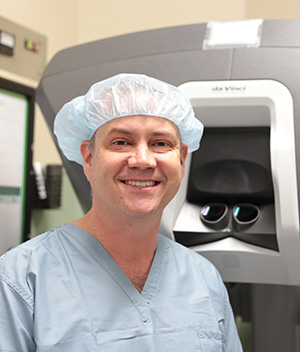Minimally-invasive surgical approaches help improve cancer survival rates
Cancer
da Vinci Surgical System allows for quicker recovery for lung cancer patients
A cancer diagnosis is a scary thing. However, it’s certainly not a death sentence.
In fact, the death rate from cancer in the United States has declined steadily over the past two decades, according to a January 2018 study by the American Cancer Society. As of 2015, the cancer death rate for men and women combined had fallen 26 percent from its peak in 1991. This decline translates to nearly 2.4 million deaths averted during this time period, the study found.

One reason for improved survival rates is advancing, minimally-invasive technology used for treatment.
The cancer specialists at the Nancy N. and J.C. Lewis Cancer & Research Pavilion offer expanded capability for many cancer surgeries through less intrusive approaches. One such approach is minimally-invasive surgery with the da Vinci Surgical System.
How the da Vinci Surgical System works
The da Vinci robot uses sophisticated computer-aided equipment which allows the surgeon to have the benefit of magnified views of regular laparoscopic surgery while retaining the three-dimensional view of traditional open surgery, all in high definition.
The surgeon sits at a console where their hands are placed into glove-like controllers, called masters, which are used to manipulate the robotic surgical EndoWrist instruments. The on-board computer replicates the surgeon’s movements precisely and to scale while filtering out the surgeon’s pulse, called tremor, normally seen at high magnification. This allows the surgeon to move in a more natural fashion as opposed to straight stick laparoscopy where the surgeon has to move the instrument left to go right thus reducing the chance of human error.
This advanced system offers breakthrough surgical capabilities to LCRP patients for improved outcomes. At St. Joseph’s/Candler, we were the first hospital in the region to use both the da Vinci Si, and the latest robot, the da Vinci Xi surgical systems. There are three da Vinci Si robots and two da Vinci Xi robot on the campuses of St. Joseph’s and Candler hospitals.
“It’s a surgical instrument now that feels so intuitive to use,” says Dr. Marc Bailey, cardiothoracic surgeon and member of the LCRP’s thoracic cancer multi-disciplinary team. “As soon as you sit down at the console, you move with small movements with your hands on the console and the instruments in the chest move to correspond that. You can do very nice detailed dissections and very minute movement.”
Let’s look at lung cancer as an example
More people die of lung cancer each year than colon, breast and prostate cancers combined. However, thanks to lung screenings, cancers are being found early, which lowers the risk of dying from this disease.
“I want to see more patients because if I am seeing the patient, it’s an earlier stage cancer and it’s tolerable to surgery, and it gives us the best chance of curing it,” Dr. Bailey says. “If we can jump on these lung screening programs and smoking cessation programs then we will pick up on early stage lung cancer.”
The lungs are a large organ that lie on either side of the mediastinum within the thoracic cavity. The left lung is comprised of two lobes while the right has three lobes.
To remove a tumor, the most common procedure performed is a lobectomy, which removes one of the lobes of the lung.
“The best cancer operation, if the patient can tolerate it and if they have cancer in one of those lobes, is not just to pluck out that little cancer, it’s to remove that lobe where the cancer sits,” Dr. Bailey says. “That’s the best chance of not seeing the cancer again.
A lobectomy is preferred over a pneumonectomy, which removes the whole lung. Dr. Bailey says those surgeries are becoming more and more rare thanks to advances in technology.
“da Vinci allows me to remove very large tumors from the lung without ever spreading a rib or breaking a rib,” Dr. Bailey says. “We’ve seen patients who wouldn’t qualify for the big incision surgeries, but when we operate with the robot, they do just fine. It’s a really nice instrument that, in my opinion, was designed for thoracic surgery.”
Additionally, robotic technology allows surgeons to clean up the lymph node basin more precisely, Dr. Bailey says. Good lymph node dissection and removal is important in lung cancer surgery.
Dr. Bailey says about 80 to 85 percent of the cancer operations he performs are done so robotically. Using the da Vinci Surgical System allows for better cancer prognosis because it reduces recovery and some inflammatory markers that can cause some recovery issues to be difficult, Dr. Bailey says. Proven benefits to minimally-invasive surgery to treat lung cancer include:
- Shorter hospital stays – two to three days compared to nine to 11
- Less blood loss
- Less need for blood transfusions
- Less pain
- Quicker recovery to regular activity
- Quicker time to adjunct therapy, such as radiation or chemo
“da Vinci has changed how well my patients have done,” Dr. Bailey says. “We’ve always been looking for the best approach that’s going to do the same operation on the inside and get the patient through what they need to get through but less invasive so they recover faster, get on with their daily lives faster or if they have something ahead of them – chemotherapy or radiation therapy – they recover quickly enough from surgery so we are not delaying additional treatment they need.”
da Vinci and minimally-invasive surgical options are available for many complex cancers. Dr. Bailey encourages patients to talk to their physician about minimally-invasive approaches and if it’s appropriate for their operation.
To learn more about the Lewis Cancer & Research Pavilion, please visit our website.